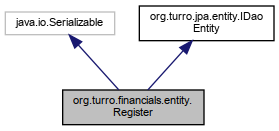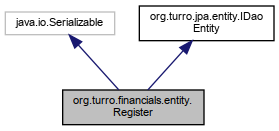- Author
- Lluis Turró Cutiller lluis.nosp@m.@tur.nosp@m.ro.or.nosp@m.g
Definition at line 40 of file Register.java.
◆ collections()
| Collection<Collection> org.turro.financials.entity.Register.collections |
( |
| ) |
|
◆ entityId()
| Object org.turro.financials.entity.Register.entityId |
( |
| ) |
|
◆ getAmounts()
| AmountSet org.turro.financials.entity.Register.getAmounts |
( |
Collection< String > |
majors | ) |
|
Definition at line 287 of file Register.java.
289 as =
new AmountSet();
290 if(document !=
null) {
291 for(RegisterEntry re : registerEntries) {
292 Account acc = re.getAccount();
293 for(String major : majors) {
294 if(acc.getId().startsWith(major)) {
295 double tax = Integer.valueOf(acc.getId().substring(5)) / 10.0;
297 double amount = re.getDebit() + re.getCredit();
298 as.
addAmount(
new Amount(tax, amount / (tax / 100.0), 0.0, 0.0, 2));
◆ getBookRegisters()
| Set<BookRegister> org.turro.financials.entity.Register.getBookRegisters |
( |
| ) |
|
◆ getBookString()
| String org.turro.financials.entity.Register.getBookString |
( |
| ) |
|
Definition at line 273 of file Register.java.
274 StringBuilder sb =
new StringBuilder();
276 if(sb.length() > 0) {
279 sb.append(br.getBookDefinition().getDescription());
280 sb.append(
" [" + (br.getBookOrder() == 0 ?
"<auto>" : br.getBookOrder()) +
"]");
282 return sb.toString();
◆ getCredit()
| double org.turro.financials.entity.Register.getCredit |
( |
| ) |
|
Definition at line 210 of file Register.java.
212 for(RegisterEntry re : registerEntries) {
◆ getDebit()
| double org.turro.financials.entity.Register.getDebit |
( |
| ) |
|
Definition at line 202 of file Register.java.
204 for(RegisterEntry re : registerEntries) {
◆ getDocument()
| Document org.turro.financials.entity.Register.getDocument |
( |
| ) |
|
◆ getDocumentAmounts()
| DocumentAmounts org.turro.financials.entity.Register.getDocumentAmounts |
( |
| ) |
|
Definition at line 311 of file Register.java.
313 if(document !=
null) {
DocumentAmounts getAmounts()
◆ getId()
| long org.turro.financials.entity.Register.getId |
( |
| ) |
|
◆ getIdRegister()
| long org.turro.financials.entity.Register.getIdRegister |
( |
| ) |
|
◆ getRegisterDate()
| Date org.turro.financials.entity.Register.getRegisterDate |
( |
| ) |
|
◆ getRegisterEntries()
| Set<RegisterEntry> org.turro.financials.entity.Register.getRegisterEntries |
( |
| ) |
|
◆ getSerializerMappings()
| MappingSet org.turro.financials.entity.Register.getSerializerMappings |
( |
| ) |
|
Definition at line 322 of file Register.java.
323 MappingSet
set =
new MappingSet();
324 set.addMapping(Register.class, 1,
325 new String[] {
"idRegister",
"registerDate" },
326 new String[] {
"view",
"registerEntries" });
327 set.addMapping(RegisterView.class, 2,
328 new String[] {
"id",
"name" },
330 set.addMapping(RegisterEntry.class, 2,
331 new String[] {
"debit",
"credit",
"approved",
"conciliated" },
332 new String[] {
"account" } );
333 set.addMapping(Account.class, 3,
334 new String[] {
"id",
"description" },
◆ getView()
| RegisterView org.turro.financials.entity.Register.getView |
( |
| ) |
|
◆ isClosing()
| boolean org.turro.financials.entity.Register.isClosing |
( |
| ) |
|
◆ isEmpty()
| boolean org.turro.financials.entity.Register.isEmpty |
( |
| ) |
|
◆ isExclude()
| boolean org.turro.financials.entity.Register.isExclude |
( |
| ) |
|
◆ isRegularizeIRPF()
| boolean org.turro.financials.entity.Register.isRegularizeIRPF |
( |
| ) |
|
◆ isRegularizeVAT()
| boolean org.turro.financials.entity.Register.isRegularizeVAT |
( |
| ) |
|
◆ killUnusedBooks()
| void org.turro.financials.entity.Register.killUnusedBooks |
( |
Set< Long > |
bookDefs | ) |
|
Definition at line 256 of file Register.java.
258 while(it.hasNext()) {
259 boolean used =
false;
260 BookRegister br = it.next();
261 for(
long bd : bookDefs) {
262 if(br.getBookDefinition().getId() == bd) {
◆ prepareSave()
| void org.turro.financials.entity.Register.prepareSave |
( |
| ) |
|
Implements org.turro.jpa.entity.IDaoEntity.
Definition at line 183 of file Register.java.
184 IDaoEntity.super.prepareSave();
185 if(idRegister == 0) {
186 idRegister = IdUtils.getMaxLongIdFromLong(
187 new FinancialsPU(),
"Register",
"idRegister",
189 "year(registerDate) = " +
new CheckDate(registerDate).getYear(),
190 "view.id = " + view.
getId()
◆ reuseLines()
| void org.turro.financials.entity.Register.reuseLines |
( |
Collection< RegisterEntry > |
entries | ) |
|
Definition at line 218 of file Register.java.
220 Iterator<RegisterEntry> it2 = entries.iterator();
221 RegisterEntry re1, re2 =
null;
222 while(it1.hasNext()) {
233 re1.assignValuesFrom(re2);
234 re1.setRegister(
this);
240 re1 =
new RegisterEntry();
241 re1.assignValuesFrom(re2);
242 re1.setRegister(
this);
243 registerEntries.add(re1);
245 while(it2.hasNext()) {
247 re1 =
new RegisterEntry();
248 re1.assignValuesFrom(re2);
249 re1.setRegister(
this);
250 registerEntries.add(re1);
◆ setBookRegisters()
| void org.turro.financials.entity.Register.setBookRegisters |
( |
Set< BookRegister > |
bookRegisters | ) |
|
Definition at line 79 of file Register.java.
80 this.bookRegisters = bookRegisters;
◆ setClosing()
| void org.turro.financials.entity.Register.setClosing |
( |
boolean |
closing | ) |
|
◆ setDocument()
| void org.turro.financials.entity.Register.setDocument |
( |
Document |
document | ) |
|
◆ setExclude()
| void org.turro.financials.entity.Register.setExclude |
( |
boolean |
exclude | ) |
|
◆ setId()
| void org.turro.financials.entity.Register.setId |
( |
long |
id | ) |
|
◆ setIdRegister()
| void org.turro.financials.entity.Register.setIdRegister |
( |
long |
idRegister | ) |
|
◆ setRegisterDate()
| void org.turro.financials.entity.Register.setRegisterDate |
( |
Date |
registerDate | ) |
|
Definition at line 127 of file Register.java.
128 if(this.registerDate !=
null && !
new CheckDate(this.registerDate).sameYear(registerDate)) {
129 bookRegisters.clear();
132 this.registerDate = registerDate;
◆ setRegisterEntries()
| void org.turro.financials.entity.Register.setRegisterEntries |
( |
Set< RegisterEntry > |
registerEntries | ) |
|
Definition at line 139 of file Register.java.
140 this.registerEntries = registerEntries;
◆ setRegularizeIRPF()
| void org.turro.financials.entity.Register.setRegularizeIRPF |
( |
boolean |
regularizeIRPF | ) |
|
Definition at line 147 of file Register.java.
148 this.regularizeIRPF = regularizeIRPF;
◆ setRegularizeVAT()
| void org.turro.financials.entity.Register.setRegularizeVAT |
( |
boolean |
regularizeVAT | ) |
|
Definition at line 155 of file Register.java.
156 this.regularizeVAT = regularizeVAT;
◆ setView()
| void org.turro.financials.entity.Register.setView |
( |
RegisterView |
view | ) |
|
The documentation for this class was generated from the following file:


 Public Member Functions inherited from org.turro.jpa.entity.IDaoEntity
Public Member Functions inherited from org.turro.jpa.entity.IDaoEntity

